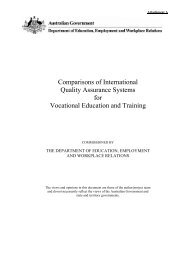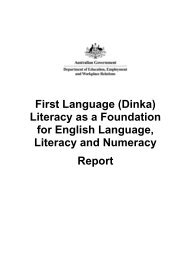Epidemics in a Changing World - Department of Innovation, Industry ...
Epidemics in a Changing World - Department of Innovation, Industry ...
Epidemics in a Changing World - Department of Innovation, Industry ...
Create successful ePaper yourself
Turn your PDF publications into a flip-book with our unique Google optimized e-Paper software.
Mobility <strong>of</strong> humans, animals and food<br />
Increased mobility <strong>of</strong> humans, animals and agricultural produce carries with it the risk <strong>of</strong><br />
exotic disease importation <strong>in</strong>to Australia, and rapid worldwide spread <strong>of</strong> <strong>in</strong>fection. Even<br />
with border controls and quarant<strong>in</strong>e requirements <strong>in</strong> place, <strong>in</strong>fectious agents can still enter<br />
Australia, for example <strong>in</strong> asymptomatic human or animal carriers.<br />
EpidemICs <strong>in</strong> a Chang<strong>in</strong>g <strong>World</strong><br />
Report <strong>of</strong> the Expert Work<strong>in</strong>g Group<br />
12<br />
There are numerous examples <strong>of</strong> how <strong>in</strong>creased mobility has led to the spread <strong>of</strong> <strong>in</strong>fection, or<br />
to the <strong>in</strong>troduction <strong>of</strong> exotic diseases <strong>in</strong>to Australia. One is the rapid spread <strong>of</strong> human <strong>in</strong>fluenza<br />
viruses along travel routes, as seen <strong>in</strong> the current 2009 A(H1N1) epidemic. Another is equ<strong>in</strong>e<br />
<strong>in</strong>fluenza: prior to 2007, Australia was one <strong>of</strong> only three countries worldwide considered free <strong>of</strong><br />
this disease 43 (Text Box 6).<br />
Text Box 6: Equ<strong>in</strong>e <strong>in</strong>fluenza 2007<br />
An example <strong>of</strong> the effect <strong>of</strong> globalised trade on animal epidemics<br />
Globalisation with the result<strong>in</strong>g <strong>in</strong>crease <strong>in</strong> the trade <strong>of</strong> animals and animal products<br />
has <strong>in</strong>creased the risk <strong>of</strong> spread <strong>of</strong> <strong>in</strong>fectious diseases. For example, equ<strong>in</strong>e <strong>in</strong>fluenza<br />
was <strong>in</strong>troduced through the importation <strong>of</strong> thoroughbred stallions. This epidemic led to<br />
the <strong>in</strong>fection <strong>of</strong> nearly 80,000 horses across New South Wales and Queensland before<br />
the disease was conta<strong>in</strong>ed and eradicated. 44 This is the first time that any country<br />
has been able to eradicate this disease. CSIRO, NSW DPI, QDPI&F, DAFF, AHA and<br />
the AB CRC all played critical roles <strong>in</strong> the eradication program. Direct costs to the<br />
Australian Government were approximately AU$ 350 million. However, <strong>in</strong>direct costs to<br />
both <strong>in</strong>dustry sectors and government were also high. For example, the thoroughbred<br />
<strong>in</strong>dustry estimated <strong>in</strong>direct costs to their <strong>in</strong>dustry <strong>of</strong> AU$ 1 billion. 45 Significant social<br />
costs were also borne by all sectors <strong>of</strong> the horse <strong>in</strong>dustry. 46<br />
A subsequent <strong>in</strong>quiry (the Call<strong>in</strong>an Inquiry) 47 found that the failure <strong>of</strong> exist<strong>in</strong>g processes<br />
led to the <strong>in</strong>troduction <strong>of</strong> the virus.<br />
Dengue fever is another example <strong>of</strong> population movement be<strong>in</strong>g associated with disease<br />
transmission. Increased potential for dengue transmission is associated both with <strong>in</strong>creased<br />
mobility due to more affordable jet travel, and with <strong>in</strong>creas<strong>in</strong>g rural to urban migration<br />
(especially <strong>in</strong> Asia).<br />
S<strong>in</strong>ce its re-emergence <strong>in</strong> 2003, the highly pathogenic avian <strong>in</strong>fluenza A(H5N1) (“bird flu”)<br />
virus has caused devastat<strong>in</strong>g disease <strong>in</strong> domestic poultry, lead<strong>in</strong>g to the death from disease<br />
or cull<strong>in</strong>g <strong>of</strong> hundreds <strong>of</strong> millions <strong>of</strong> ducks and chickens. The virus is known to have <strong>in</strong>fected<br />
more than 420 humans with about 60% mortality. Today highly pathogenic H5N1 is endemic <strong>in</strong><br />
poultry <strong>in</strong> some countries, notably Indonesia, and cont<strong>in</strong>ues to cause serious human <strong>in</strong>fections,<br />
<strong>in</strong>clud<strong>in</strong>g at least 23 <strong>in</strong> Egypt <strong>in</strong> 2009 to date. Although migratory birds are thought to have<br />
contributed, the most important factors <strong>in</strong> the spread <strong>of</strong> this virus throughout south east and<br />
central Asia <strong>in</strong>to Europe and Africa have been the m<strong>in</strong>gl<strong>in</strong>g <strong>of</strong> birds <strong>in</strong> live bird markets and the<br />
transport <strong>of</strong> <strong>in</strong>fected poultry or poultry products. The dependence <strong>of</strong> many people <strong>in</strong> develop<strong>in</strong>g<br />
countries on poultry for <strong>in</strong>come and food, and the difficulties <strong>in</strong> controll<strong>in</strong>g cross-border trade,<br />
mean that there is currently little prospect <strong>of</strong> controll<strong>in</strong>g the spread <strong>of</strong> this virus <strong>in</strong> large areas<br />
<strong>of</strong> the world and it rema<strong>in</strong>s a significant pandemic threat.
















